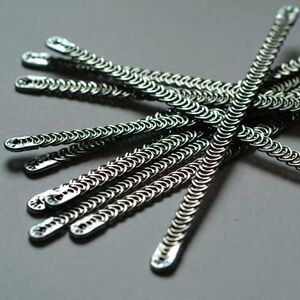
Spiral steel bones.
Boning is the rigid material used to stiffen a corset. It is usually long and narrow and fits into narrow channels or pockets inside the corset.
Materials[]
For most of its history, whalebone has provided the support structure for the corset. However, even before the commercial slaughter of whales began to be considered unethical at the turn of the 20th century, it had become increasingly scarce and expensive, and corsetiers found that steel was a cheaper alternative that was more widely available and much less bulky.
In the 16th and 17th centuries, reeds were often used to stiffen the bodice. The most popular variety were Giant Reeds. These were laid in bunches in adjacent channels which completely encircled the garment. Reeds are somewhat flexible and much lighter than their artificial or steel counterparts.
Spring steel or white steel is the flatter and stiffer of the two steel options available today, while spiral steel is more flexible and, some believe, less restrictive. Steel bones of any variety are the strongest bones one can find and the only material which can actually reshape the body, and as such are especially favored by tightlacers or those replacing whalebone in heavily boned historical reproductions.
Artificial whalebone can also be used, but is very expensive and can be difficult to find.
Other man-made options such as plastics, nylon, and Rigilene are popular choices for boning in inexpensive mass-produced corsets, some corset tops, bodices, formal gowns, and lingerie. These bones are flexible and not particularly rigid, and are less than ideal choices for high-quality corsets intended for any sort of waist reduction, as they are known to be easily bent, sometimes in unflattering ways. However, they are much less expensive options than steel and other alternatives, and often the garments may not be as comfortable or have the same shape with more rigid stiffening.
Uses[]
Most purchased boning comes in pre-made casing. It is also possible to make casings by hand, although beginning sewers may find it tedious.
Boning is usually laid along the seams of a corset or corset-like garment for structure support, although some corsets, such as those at the end of the 19th century, had boning that did not follow the seams. Some corsets, like those from the Tudor era, were fully boned; that is, the boning channels were adjacent to one another, with little or no space in between.
Busks[]
Main article: Busks
Busks are flat, rigid pieces of boning that are most often wider than those used in the rest of the garment. They are usually quite wide and are usually inserted in the front of the corset. Early stays used a busk made of wood, ivory, or whalebone and completely enclosed it in a pocket. Modern busks comprise two parts, allowing the front of the corset to open and close with hook-and-eye devices.